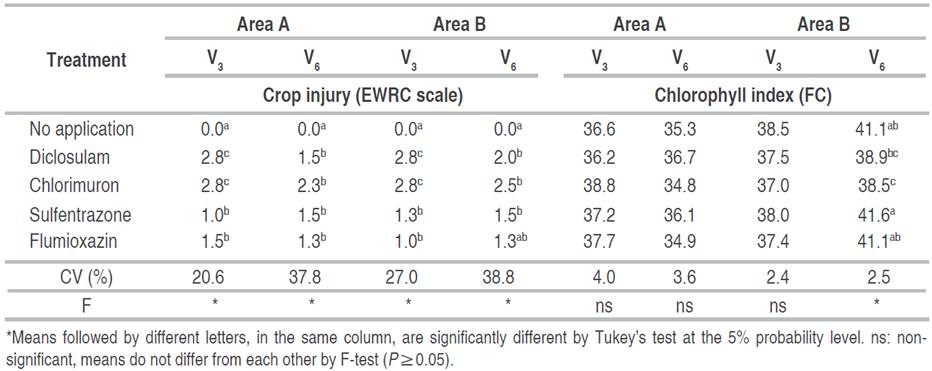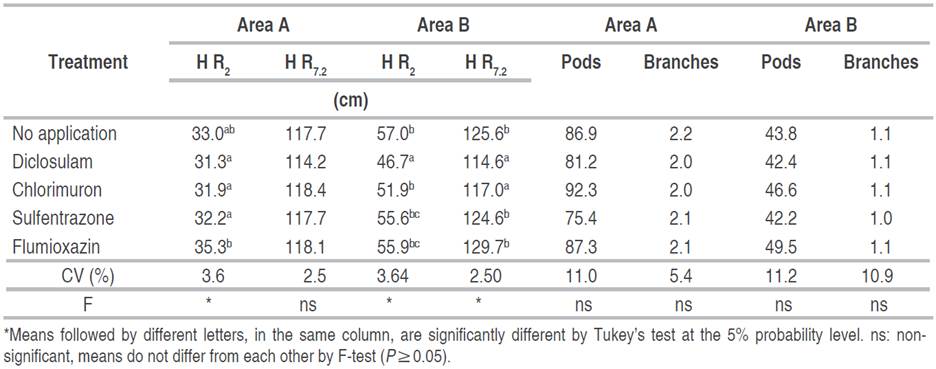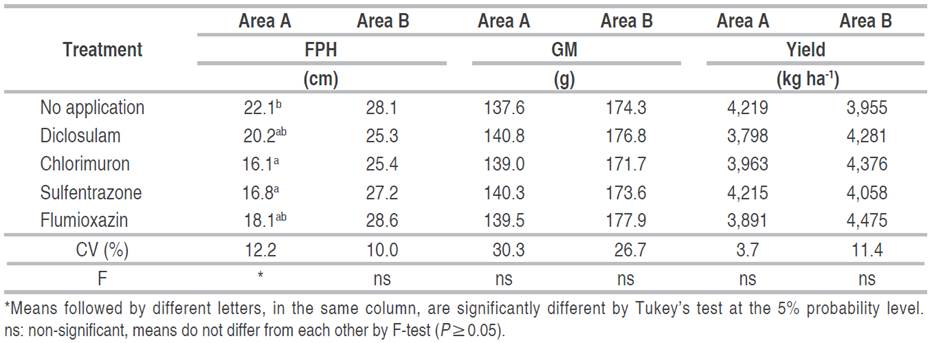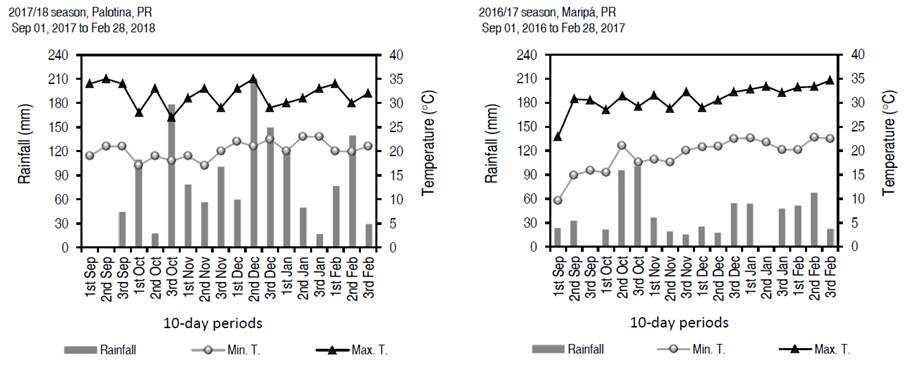Lodging is defined as the process of plant falling or bending. This problem usually occurs from the flowering stage onwards and can extend until the full maturity of the grains, especially in cultivars with greater potential for vegetative growth (Kitabatake et al. 2019; Shan et al. 2022). Lodging can reduce grain yield and quality, favor the development of diseases and pest attacks (Knebel et al. 2006), and make mechanized harvesting difficult (Saitoh et al. 2012; Kitabatake et al. 2019). Thus, it is a limiting factor to the yield potential of soybeans (Hwang and Lee 2019; Shan et al. 2022).
Due to lodging, the proximity of leaves and shading of the upper part of the plant under the lower part is inevitable. In this case, there is a lower incidence of solar radiation on the leaves in the lower parts, reducing the photosynthesis of the shaded parts, the net photosynthesis of the plant community, and the availability of photoassimilates to be used in grain filling (Hussain et al. 2021; Shan et al. 2022). The genotype, high water availability, high soybean fertility, and spatial arrangement of plants, among other factors can contribute to soybean lodging. These factors can lead to massive vegetative growth and, consequently, plant lodging (Hwang and Lee 2019; Li et al. 2022).
Growth regulators or herbicides may be used pre- or post-emergence in soybean to minimize the chance of lodging. These can act to reduce the height or number of branches; however, these products must be selective to soybean plants, i.e., not reduce their yield (Ramesh and Ramprasad 2015). In this way, some can highlight some herbicides that can be applied at the pre-emergence of soybean. Osipe et al. (2014) observed a reduction in soybean plant height after applying chlorimuron, diclosulam, sulfentrazone, and flumetsulam, at pre-emergence, but without reducing yield.
In addition to lodging, another very important factor limiting soybean yield is competition with weeds. For example, in soybean crops, Digitaria insularis and Conyza spp., stand out, among other weeds. Studies highlight that few plants of these species can already reduce soybean yield by more than 40% (Gazziero et al. 2019). Thus, effective control of these weeds is necessary, but both have cases of glyphosate resistance. The application of pre-emergence herbicides in soybeans also deserves attention for weed control. Because of the possibility of using different modes of action, early management of weeds is one of the most critical aspects in preventing and selecting resistant biotypes and their control (Knezevic et al. 2019). Studies highlight the efficacy of diclosulam (Braz et al. 2017), chlorimuron (Sarangi and Jhala 2019), and sulfentrazone (Sarangi et al. 2017) in weed control and for pre-emergence application in soybean. As mentioned, these herbicides can also reduce the height of soybean plants, so soybean pre-emergence herbicides can be used for different purposes.
However, these herbicides must be selective for soybean plants, i.e., they cannot reduce yield. Some studies report symptoms of injury to soybeans with the application of diclosulam (Neto et al. 2009) and sulfentrazone (Belfry et al. 2016). Thus, the importance of using soybean pre-emergence herbicides for different purposes is highlighted, but they need to be evaluated for crop selectivity. Therefore, this study aimed to evaluate the growth and agronomic performance of soybean applied with pre-emergence herbicides.
MATERIALS AND METHODS
Two experiments (1 and 2) were conducted in a production area in the western region of the state of Paraná (PR), Brazil. Experiment 1 was conducted in the 2017-2018 growing season at two locations in the municipality of Palotina (A: 24°18'44" S 53°44'36" W, B: 24°20'50" S 53°51'38" W), and experiment 2 in the 2016-2017 growing season at a location in the municipality of Maripá (24°23'21.6''S 53°45'47.3''W). The prevailing climate of the region is Cfa (subtropical, with hot summers), by the Köppen classification. Figure 1 illustrates climatic data during the experimental period.
Experiment 1 (A) was carried out on soil with 68.75% clay, 15% silt, 16.25% sand, pH=5.3 (CaCl2), and organic matter (OM) 24.94 g dm-3. Formerly, the area had been planted with maize. Sowing was carried out under no-till on September 7, 2017. Monsoy® 6210 IPRO cultivar (Monsanto Co. Brasil, São Paulo, SP, Brazil) was used, which has an indeterminate growth habit, moderately resistant to lodging, 96 cm average height, 125-day average cycle, and 6.2 maturity group.
Experiment 1 (B) was carried out on soil with 69% clay, 15% silt, 16% sand, pH=4.7 (CaCl2), and OM: 28.60 g dm-³.
Formerly, the area had been cultivated with wheat. Sowing was done in no-till conditions on October 16, 2017. TMG 7062 IPRO cultivar (Tropical Melhoramento & Genética, Cambé, PR, Brazil) was used. It has a semi-determinate growth habit, 125-day average cycle, and 6.2 maturity group. In both areas of experiment 1, fertilization was performed at sowing with 300 kg ha-1 02-20-20 (N-P-K).
The experiments were a randomized block design with 3x5 m plots, with four replications. The treatments are described in Table 1. Herbicides were applied with a CO2 pressurized backpack sprayer at a constant pressure of 2 bar, flow of 0.45 L min-1 flow rate of 150 L ha-1, with a 3 m spray bar, equipped with six spray nozzles (XR 110.015), at a speed of 1 m s-1.
The treatments were applied 1 day after planting for experiment 1 (A) on September 8, 2017, at a temperature of 24.4 °C, relative humidity of 49.9%, and wind speed of 2 km h-¹, without rain in the 10 days following the application. In experiment 1 (B), on October 7, 2017, at a temperature of 20.5 °C, relative humidity of 63.2%, and wind speed of 3 km h-1, with 18 mm rain in the 10 days following the application, without rain on the day of application. For experiment 2, on September 8, 2016, at 25 °C, relative air humidity of 59%, and wind speed of 2 km h-¹, with 33 mm of rain in the 10 days following the application, without rain on the day of application.
For experiment 1, assessments were performed for injury symptoms at vegetative stages V3 and V6 of soybean plants, using the adaptation of the European Weed Research Council [EWRC] scale, with values from 0 to 9, with 0 for no damage (0% injury) and 9 for plant death (100% injury). Chlorophyll A, B, and total chlorophyll were determined with an electronic chlorophyll meter (clorofiLOG - CFL1030, Falker Automação Agrícola Ltda., Brazil). This equipment determines the Falker chlorophyll index (FCI). The chlorophyll index was always evaluated on the central leaf of the first fully expanded trifolium.
Plant height, number of pods and branches, and yield were analyzed in all experiments. Plant height was measured using a graduated ruler from the base of the plant to the last node with fully expanded trifolium in five plants per experimental plot at R2 and R7.2 stages. The first pod height was also determined during the height assessment at R7.2. On this occasion, the number of branches and the number of pods were also counted in five plants per plot.
Harvesting was performed manually at the R8 stage in the entire useful area of each plot. Pods were threshed in a thresher for experiments, cleaned, and packed in paper bags for further analysis. Grains produced in each plot were weighed and the moisture was corrected to 13%; from these data was calculated the yield in kg ha-1.
Data were tested by analysis of variance (ANOVA) and F-test (P≤0.05). When significant, treatment means were grouped by Tukey's test (P≤0.05). All analyses were run in Sisvar 5.6 (Ferreira 2011).
RESULTS AND DISCUSSION
The results showed soybean injury caused by herbicide application in both areas of experiment 1. In addition, symptoms were found in assessments at V3 and V6, with values not exceeding 2.8 (EWRC scale). For chlorophyll indices, differences were detected between treatments only for the evaluation at V6 in area B, when the application of diclosulam or chlorimuron reduced the index compared to the control treatment (no application) (Table 2).
Table 2 Crop injury and total chlorophyll index of soybean plants under application of herbicides in pre-emergence (experiment 1).

The application of chlorimuron can cause injuries to soybeans, especially when applied post-emergence of soybeans (Cesco et al. 2018; Silva et al. 2018a). For pre-emergence application, injury in soybeans is less common, but can also be observed, but in general without compromising agronomic performance (Belfry et al. 2015; Priess et al. 2020), as observed in the present study. Also, for the application of diclosulam in pre- or post-emergence of soybeans, symptoms of injury can be observed, in general, up to two weeks after application (Neto et al. 2009; Braz et al. 2017), with subsequent recovery of soybean plants.
Some differences between treatments were found for plant height (experiment 1), mainly for diclosulam, which reduced the height of soybean plants, in the assessments at R2 (to 31.3 cm) and R7.2 (to 46.7 cm). For chlorimuron, at R7.2 (to 51.9 cm), these effects were observed in area B. For the number of pods and branches per plant, there were no differences in both areas (Table 3). For the first pod height, some differences were verified in area A, with a reduction for the application of chlorimuron or sulfentrazone.
Table 3 Height (H), number of pods and branches of soybean plants under application of herbicides in pre-emergence (experiment 1).

The application of diclosulam also reduced soybean plant height by 36% at 30 DAA in another study (Dalazen et al. 2020). Herbicides sulfentrazone and flumioxazin can also reduce the height of soybean plants, as reported by Barbosa et al. (2023), but mainly for post-emergence soybean application. In the present study, herbicides that caused height reduction were applied in soybean pre-emergence.
For 1,000-grain mass and yield, in both areas, no differences were detected between treatments (Table 4). Table 5 lists the results of experiment 2. No differences were registered between treatments for the analyzed variables, an exception to that observed for height at R2; however, no herbicide reduced the height about the treatment with weeding (no application).
Table 4 First pod height (FPH), 1,000-grain mass (GM), and yield of soybean plants under application of herbicides in pre-emergence (experiment 1).

Table 5 Height (H), first pod height (FPH), number of pods, 1,000-grain mass (GM), and yield of soybean plants under application of herbicides in pre-emergence (experiment 2).

Regarding the potential use of pre-emergence herbicides to reduce the height of soybean plants, chlorimuron and diclosulam can be highlighted. In some situations, as in this study, these herbicides have reduced plant height, which makes plants less susceptible to lodging. Cesco et al. (2018) reported a reduction in the height of soybean plants for the post-emergence application of chlorimuron (17.5 g active ingredient [a.i.] ha-1) + glyphosate. Similar to that observed by Dias et al. (2019) for the post-emergence application of chlorimuron in soybean.
Osipe et al. (2014) reported a reduction in soybean plant height for the application of chlorimuron (20 g a.i. ha-1 ) and diclosulam (25.2 g a.i. ha-1) in pre-emergence of soybean, as found in the present study. This reinforces the potential of these herbicides for this purpose in soybean. Likewise, Neto et al. (2009) with the application of diclosulam + glyphosate, also in the pre-emergence of soybean.
Several factors can contribute to soybean lodging, including genotype, high water availability, high soybean fertility, and spatial arrangement of plants, among others. These factors can lead to incredible vegetative growth and, consequently, plant lodging (Hwang and Lee 2019; Raza et al. 2020). Thus, the decrease in soybean plant height is essential in reducing plant lodging. In this sense, herbicides chlorimuron and diclosulam, as demonstrated in this study, can be used to reduce the height of soybean plants without a negative impact on other yield components.
Although the other herbicides did not reduce the height of soybean plants, the results in this study classify them as selective for soybean, which is very important because these herbicides have great potential for weed management in soybean. In turn, chlorimuron and diclosulam, in addition to their potential to reduce the height of soybean plants, were also selective for the crop. In other studies, diclosulam was also selective for soybean in different combinations (Osipe et al. 2014; Braz et al. 2017). Also, chlorimuron was selective for soybean, as demonstrated by Silva et al. (2018b); Albrecht et al. (2018); Abugho et al. (2019), among others.
Other studies report the selectivity of sulfentrazone (Belfry et al. 2016), flumioxazin (Hay et al. 2019), s-metolachlor (Fornazza et al. 2018), pendimethalin (Yadav et al. 2017), trifluralin (Movahedpour et al. 2010), imazethapyr (Belfry et al. 2015), and oxyfluorfen (Cataneo et al. 2005) for soybean. The use of pre-emergence herbicides with different mechanisms of action and mixtures of these herbicides are fundamental for the management and prevention of selection of herbicide-resistant weed biotypes. The results obtained in this study evidence the selectivity of herbicides for soybean, including for application of imazethapyr/flumioxazin (premix formulation), which combines two different mechanisms of action.
CONCLUSIONS
Diclosulam and chlorimuron showed potential for application at pre-emergence of soybean to reduce plant height and consequently plant lodging. Moreover, diclosulam, chlorimuron, sulfentrazone, flumioxazin, s-metolachlor, pendimethalin, trifluralin, imazethapyr/flumioxazin, and oxyfluorfen did not negatively affect agronomic performance when applied at pre-emergence of soybean. This study evidences the selectivity of pre-emergence herbicides for soybean.

















